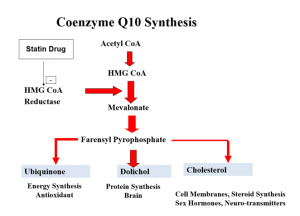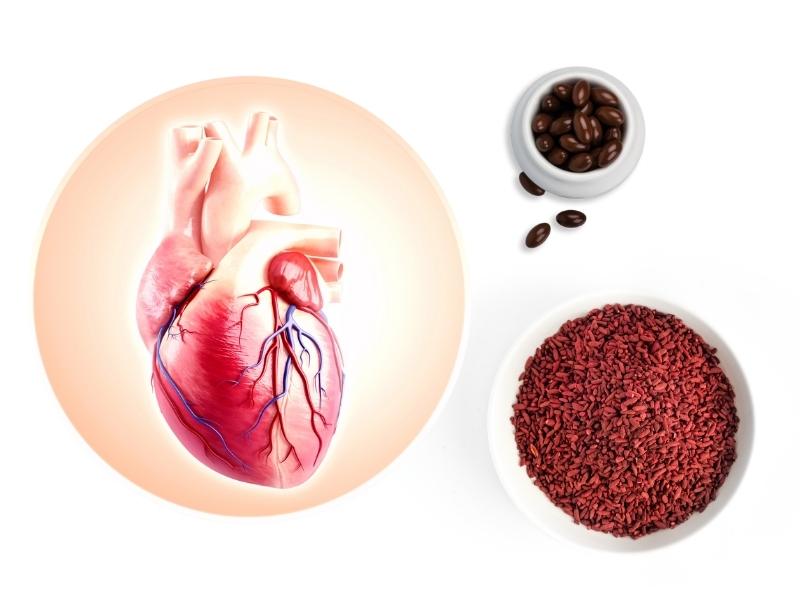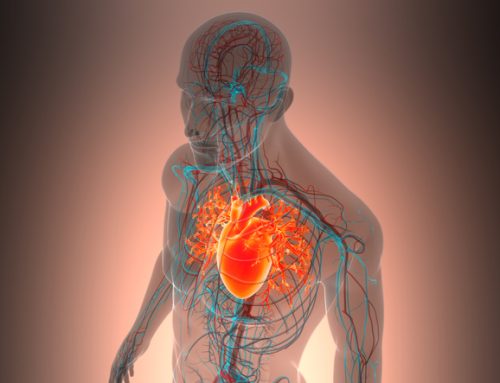
Illustration showing how statin medications block the bio-synthesis of Coenzyme Q10 just as statin medications block the body’s synthesis of cholesterol. Blocking the bio-synthesis of Coenzyme Q10 ultimately deprives the heart muscle cells of ATP energy and of antioxidant protection. Illustration courtesy of Dr. William Judy, SIBR Research Institute.
Heart disease continues to be the number 1 cause of death in the developed world. Much research has been done on efforts to modify some of the known risk factors for heart disease:
- Diet
- Exercise
- Lifestyle
However, modifying these risk factors alone is not always sufficient to prevent heart disease. Hence, the extensive prescription of statin medications in the United States because changing the lipid profiles of potential heart disease patients is do-able and effective.
But the statin medications are not without adverse effects. Even in generally healthy study participants given moderate statin doses, there can be unfavorable statin medication effects on energy and exertional fatigue. Both simvastatin and pravastatin have been seen to contribute to a significant adverse effect of statins on energy and fatigue with exertion [Golomb 2012; Okuyama and Langsjoen 2015].
Nutraceuticals containing Coenzyme Q10 against heart disease
One possible counter-proposal to the use of statin medication — or one possible measure to reduce the dosage of the statin medication– is the use of a carefully formulated nutritional supplement.
Nutritional supplements are sometimes called nutraceuticals because they are medical devices that fit somewhere between pure nutrients (food) and medications (pharmaceutical drugs).
Nutraceuticals that change the blood’s lipid profile most likely need to include a well-formulated Coenzyme Q10 supplement.
Synergy of Coenzyme Q10 and red yeast rice combinations
Red yeast rice is produced during the fermenting of white rice together with a specific yeast species Monascus purpureus. Taken as a nutritional supplement, red yeast rice acts in much the same way as the more widely used statin medications: it inhibits the activity of the HMG-Coenzyme A reductase enzymes. It inhibits the activity that is necessary for the bio-synthesis of cholesterol [Cicero].
Because the inhibition of the activity of the HMG-Coenzyme A reductase enzymes – whether by statin medications or red yeast rice – also stifles the bio-synthesis of the essential substance Coenzyme Q10, it is necessary to add a pharmaceutical-grade Coenzyme Q10 supplement as an adjuvant treatment [Cicero].
Red yeast rice and Coenzyme Q10 go together like bacon and eggs. Dr. Arrigo Cicero and his colleagues at the University of Bologna in Italy found that the synergy between red yeast rice and Coenzyme Q10 yields positive outcomes with regard to the following heart disease risk factors:
- Significant reduction of total cholesterol
- Significant reduction of LDL-cholesterol
- Significant reduction of non-HDL-cholesterol
- Significant reduction of hs-CRP (a bio-marker for inflammation)
- Significant reduction of GOT and GPT liver enzymes (bio-markers for liver function)
There was also a trend toward improvement of fasting glucose and insulin levels associated with the active nutraceutical treatment, but the improvement did not reach the level of statistical significance.
How Dr. Cicero and his colleagues did the study is interesting.
Study design to test red yeast rice and Coenzyme Q10
The researchers set up a randomized, double-blind, cross-over study to test the effectiveness of the nutritional supplements in reducing heart disease risk factors in patients diagnosed with moderately high cholesterol levels (LDL-cholesterol levels between 130 and 190 milligrams per deciliter).
- 4-week period of diet and exercise stabilization
- 6-week period of treatment with the nutritional supplement or with placebo
- 2-week washout period
- 6-week period of treatment with the alternative to the treatment in the first 6-week period
The researchers collected clinical and laboratory data at baseline, after the first 6-week treatment period, after the washout period, and after the second 6-week treatment period [Cicero].
Dosages used in the red yeast rice and Coenzyme Q10 study
For the active treatment, the researchers administered a combination of the following nutritional supplements:
- 200 milligrams of red yeast rice (equivalent to 10 milligrams of the active ingredient monacolin K) = for its cholesterol lowering properties
- 50 milligrams of Coenzyme Q10 = for its cellular bio-energetics and antioxidant properties
- 500 milligrams of artichoke extract = for its liver-protective and bile enhancing properties
- 75 milligrams of banaba extract = for its blood glucose lowering properties
- 9 milligrams of vitamin B3
- 1.4 milligrams of vitamin B6
- 0.83 micrograms of vitamin B12
- 110 micrograms of folic acid
Note: The banaba plant is a tropical plant found in the Philippines and much of Southeast Asia. Its dried and shredded leaves seem to have protective effects against diabetes and kidney disease.
Safety of the red yeast rice-Coenzyme Q10-banaba plant extract nutraceutical combination
Dr. Cicero and his colleagues report that the nutraceutical supplement was well tolerated by the patients diagnosed with moderately high cholesterol levels.
Conclusion: red yeast rice and Coenzyme Q10 combination safe and effective
Of course, we would like to see more randomized controlled studies of this combination, and we would like to see a study with a larger sample size.
But, the results are very encouraging. Dr. Cicero’s study suggests that red yeast rice and Coenzyme Q10 in combination may be a viable alternative to statin medications for patients who have difficulty with cumulative high statin dosages.
In a related study, Dr. Giuseppe Marazzi and his colleagues in Rome, Italy, have shown that low-dose statin therapy together with an adjuvant nutraceutical combination containing both red yeast rice and Coenzyme Q10 is well tolerated and effective in patients with coronary artery disease and high-dose statin intolerance.
The researchers in Rome concluded that a combination of low-dose statin therapy and adjuvant red yeast rice and Coenzyme Q10 treatment represents a valuable therapeutic option to high-dose statin therapy.
Sources
Cicero, A. G., Colletti, A., Fogacci, F., Bove, M., Rosticci, M., & Borghi, C. (2017). Effects of a Combined Nutraceutical on Lipid Pattern, Glucose Metabolism and Inflammatory Parameters in Moderately Hypercholesterolemic Subjects: A Double-blind, Cross-over, Randomized Clinical Trial. High Blood Pressure & Cardiovascular Prevention, 24(1), 13-18. doi:10.1007/s40292-016-0163-2
Golomb, B. A., Evans, M. A., Dimsdale, J. E., & White, H. L. (2012). Effects of statins on energy and fatigue with exertion: results from a randomized controlled trial. Archives Of Internal Medicine, 172(15), 1180-1182. doi:10.1001/archinternmed.2012.2171
Marazzi, G., Campolongo, G., Pelliccia, F., Quattrino, S., Vitale, C., Cacciotti, L., & … Rosano, G. (2017). Comparison of Low-Dose Statin Versus Low-Dose Statin + Armolipid Plus in High-Intensity Statin-Intolerant Patients with a Previous Coronary Event and Percutaneous Coronary Intervention (ADHERENCE Trial). The American Journal of Cardiology, 120(6), 893-897. doi:10.1016/j.amjcard.2017.06.015
Okuyama, H., Langsjoen, P. H., Hamazaki, T., Ogushi, Y., Hama, R., Kobayashi, T., & Uchino, H. (2015). Statins stimulate atherosclerosis and heart failure: pharmacological mechanisms. Expert Review of Clinical Pharmacology, 8(2), 189-199.
The information presented in this review article is not intended as medical advice and should not be construed as such.









Leave A Comment